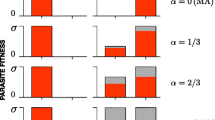Abstract
Kleptoparasitism, the stealing of food items, is a common biological phenomenon which has been modelled mathematically in a series of recent papers. A common assumption, following early work, was that mixed strategy solutions were not possible. In this paper we consider the evolution of mixed strategies under adaptive dynamics and show that such mixed strategies can be stable solutions under certain assumptions. In particular we revisit the recent paper of Broom et al. (Bull math Biol 66, 1645–1658, 2004) which assumed pure solutions only, and reanalyze the model under this new formulation.
Similar content being viewed by others
References
Barnard C.J, Sibly R.M. (1981). Producers and scroungers: a general model and its application to captive flocks of house sparrows. Anim Behav 29:543–555
Brockmann H.J., Barnard C.J. (1979). Kleptoparasitism in birds. Anim Behav 27:487–514
Broom M., Ruxton G.D. (1998). Evolutionarily Stable stealing: Game theory applied to kleptoparasitism. Behav Ecol 9:397–403
Broom M., Ruxton G.D. (2003). Evolutionarily Stable kleptoparasitism : consequences of different prey types. Behav Ecol 14:23–33
Broom M., Luther R.M., Ruxton G.D. (2004). Resistance is useless? Extensions to the game theory of kleptoparasitism. Bull Math Biol 66:1645–1658
Eshel I. (1983). Evolutionary and continuous stability. J Theoret Biol 103:99–111
Furness R.W. (1987). Kleptoparasitism in seabirds. In: Croxall J.P. (eds) Seabirds: Feeding Ecology and Role in Marine Ecosystems. Cambridge University Press, London
Hofbauer J., Sigmund K. (1990). Adaptive dynamics and evolutionary stability. Appl Math Lett 3:75–79
Holling C.S. (1959). Some characteristics of simple types of predation and parasitism. Can Entomol 91:385–398
Kitowski I. (2005). Sex skewed kleptoparasitic exploitation of common kestrel Falco tinnunculus: the role of hunting costs to victims and tactics of kleptoparasites. Folia Zool 54:371–378
Krebs J.R., Davies N.B. (1993) An introduction to Behavioural Ecology, 3rd ed. Blackwell, Oxford
Luther R.M., Broom M. (2004). Rapid convergence to an equilibrium state in kleptoparasitic populations. J Math Biol 48:325–339
Luther, R.M., Broom, M., Ruxton, G.D.: Is food worth fighting for? ESS’s in mixed populations of kleptoparasites and foragers. Accepted by the Bull Math Biol
Maynard S.J. (1982). Evolution and the theory of games. Cambridge University Press, London
Maynard S.J., Price G.R. (1973). The logic of animal conflict. Nature 246:15–18
Metz J.A.J., Nisbet R.M., Geritz S.A.H. (1992). How should we define “fitness” for general ecological scenarios?. Trends Ecol Evol 7:198–202
Metz J.A.J., Geritz S.A.H., Meszena G., Jacobs F.J.A., van Heerwaarden J.S (1996). Adaptive dynamics: a geometrical study of the consequences of nearly faithful reproduction. In: van Strien S.J. and Veruyn Lunel S.M. (eds) stochastic and Spatial Structures of Dynamical Systems. Elsevier, Amsterdam, pp. 183–231
Nowak M., Sigmund K. (2004). Evolutionary Dynamics of Biological Games. Science 303:793–799
Ohtsuki H. (2004). Reactive strategies in indirect reciprocity. J Theoret Biol 227:299–314
Page K., Nowak M. (2002). Unifying evolutionary dynamics. J Theoret Biol 219:93–98
Ruxton G.D., Broom M. (1999). Evolution of kleptoparasitism as a war of attrition. J of Evol Biol 12:755–759
Shealer D.A., Spendelow J.A. (2002). Individual foraging strategies of kleptoparasitic Roseate Terns Waterbirds 25:436–441
Stillman R.A., Goss-Custard J.D., Caldow R.W.G. (1997). Modelling interference from basic foraging behaviour. J Anim Ecol 66:692–703
Author information
Authors and Affiliations
Corresponding author
Additional information
The second author was supported by the UNCG New Faculty Grant.
Rights and permissions
About this article
Cite this article
Broom, M., Rychtář, J. The Evolution of a Kleptoparasitic System under Adaptive Dynamics. J. Math. Biol. 54, 151–177 (2007). https://doi.org/10.1007/s00285-006-0005-2
Received:
Revised:
Published:
Issue Date:
DOI: https://doi.org/10.1007/s00285-006-0005-2




